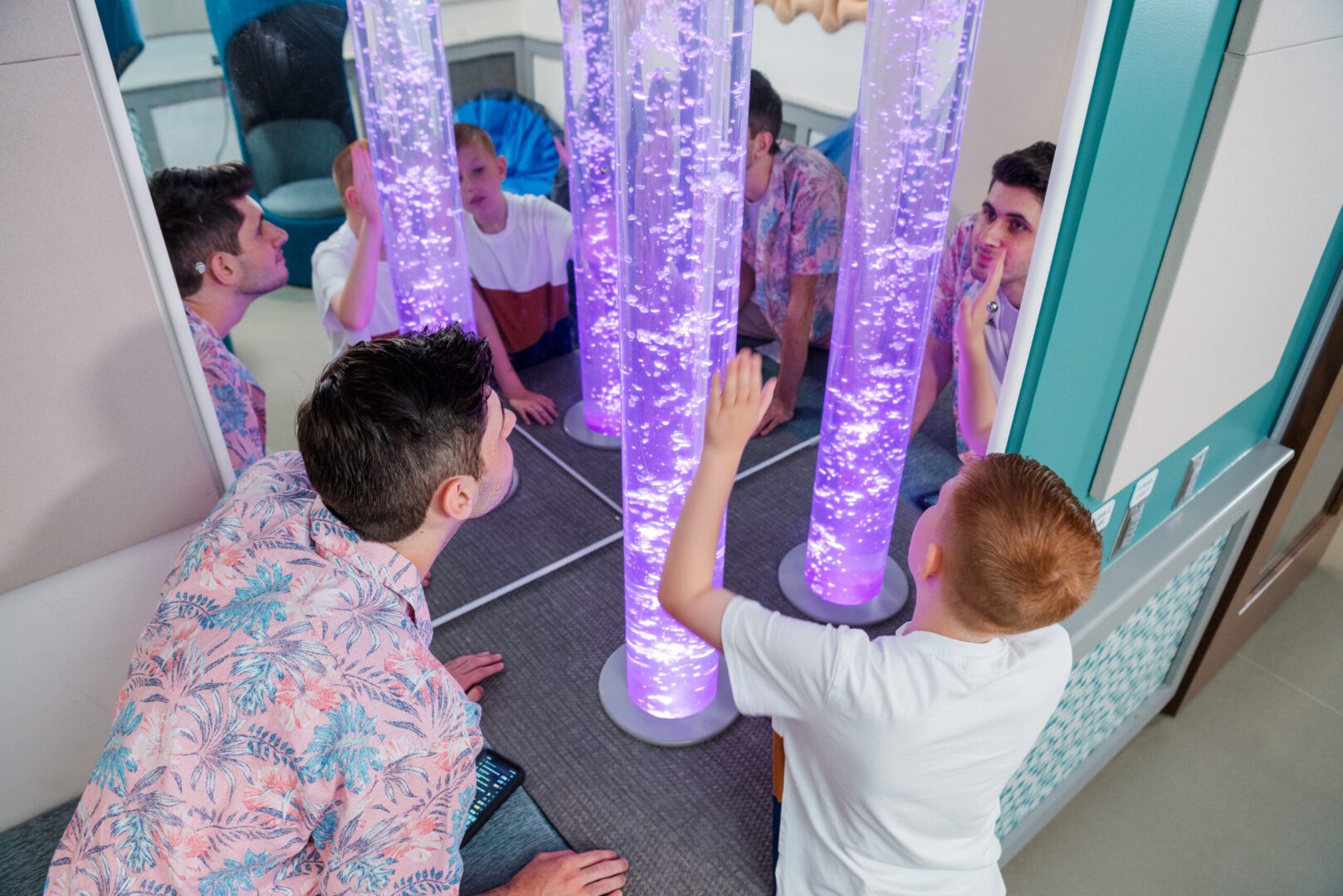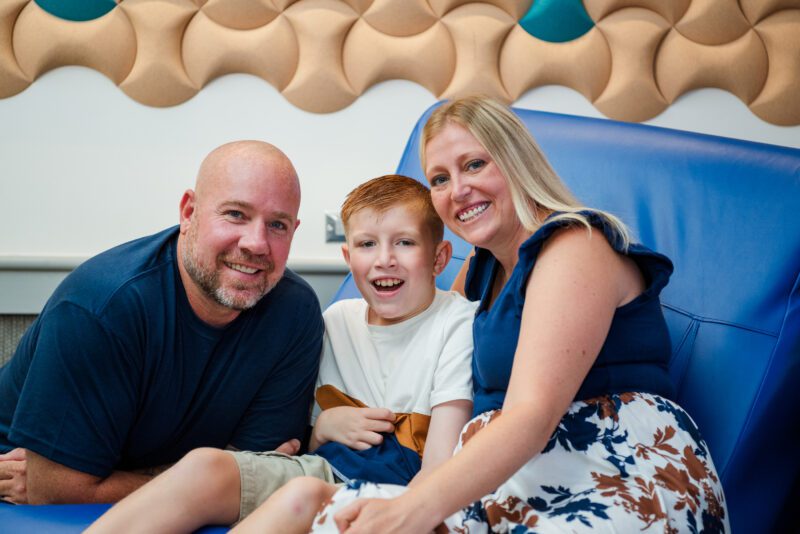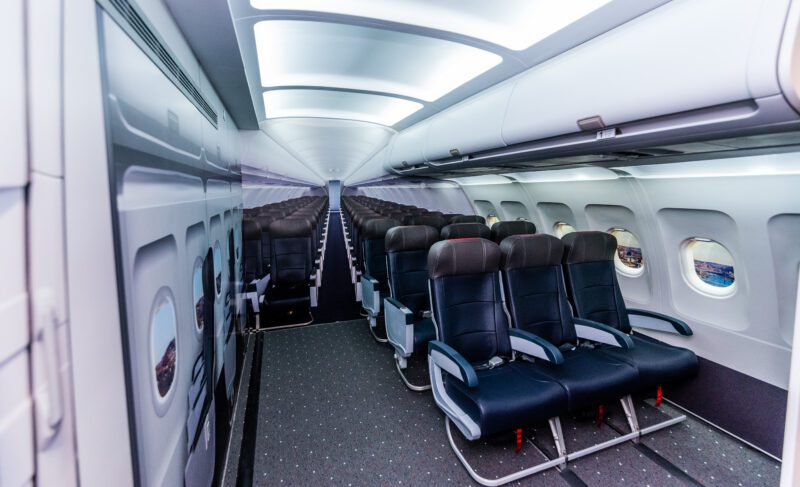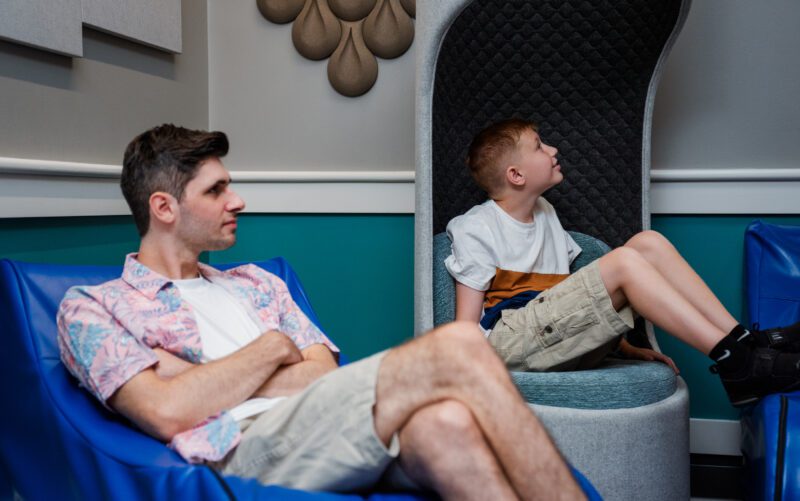Celebrating Five Years of Life-Changing Service at Presley’s Place
WATCH: PIT’s sensory room inspires other airports to follow suit, making travel more accessible for all
By Gina Mastrangelo & Julie Bercik
Published September 30, 2024
Read Time: 5 mins

Jason Rudge is a heavy equipment operator at Pittsburgh International Airport – a longtime team member who helps ensure day-to-day safety operations at the airport.
He’s also the person who sparked an idea that has made travel easier for hundreds of families.
Rudge’s son Presley, whom Rudge calls his best friend, has autism. Because airports can be overstimulating environments, Rudge assumed he and his now 9-year-old son would never be able to fly out of PIT together – until he started thinking about how Pittsburgh’s airport might help travelers like Presley in an innovative way.
Rudge dropped a letter to PIT CEO Christina Cassotis into a CEO suggestion box with the idea to build a sensory room at the airport, and Cassotis heard him. Two years later in 2019, the space officially opened its doors and was named for the person who inspired it: Presley’s Place.
Presley’s Place is a sensory room designed for travelers with autism or sensory sensitivities to de-escalate and escape the busy airport environment. The space features comfortable seating, adjustable lighting and a realistic aircraft cabin experience, donated in part by American Airlines.
Presley’s Place has collected accolades since it opened. In 2023, Fast Company Magazine recognized the sensory room in its nationwide Innovation by Design Awards, where it was named a finalist in the Accessible Design category and received an honorable mention for Experience Design.
Passengers have praised the space for the difference it’s made when they travel. Travelers have called it “life-changing” and recognized how it opens up a new travel experience for their families.
“When I wrote the letter, I wasn’t sure if this was going to be possible, and if it was, I didn’t know what it would do.” Rudge said. “I didn’t realize it would impact the country, or even the world.”
This year, Presley’s Place celebrates its fifth anniversary. To mark the milestone, PIT is hosting a panel featuring leaders in accessibility and some of the people who helped bring the space to life.
Jason and his wife Sharon also marked the milestone, recently visiting the room with Presley, who immediately knew he was in his place.
Presley may have been one of the first people to ever use the sensory room, but he wasn’t the last.

The Rudge family recently visited Presley’s Place to mark five years since its opening at PIT. (Photo by Joshua Vazquez)
Praise for a “Life-Changing” Place
One of these travelers is Angie Kotula, who has a son with an autism diagnosis. Kotula says she never took her son, Nick Logero, now aged 22, on flights when he was younger in fear of how he might react to air travel.
“If I would’ve known that a place like this existed, I would have probably taken him on a trip on an airplane a lot sooner than age 21,” Kotula said. “It feels nice to be treated equally. Knowing that the Pittsburgh International Airport values that makes me not only excited to travel but it makes me a proud community member,” she added.
Her son enjoyed visiting the space for the first time too.
“It’s calm and quiet,” he said. “It lets you calm down over the loud noises of the airport.”

Located near gate A9 in Concourse A, Presley’s Place offers nearly 1,500-square-feet of space featuring individual rooms with adjustable lighting and calming activities for its visitors. (Photo by Beth Hollerich)
Other airports take inspiration
After Presley’s Place initially opened, PIT quickly saw requests from airports in San Francisco, Dallas-Fort Worth and Grand Rapids, Michigan, alongside inquiries from the Missouri Children’s Hospital, Cincinnati Zoo and San Antonio Public Library, all wanting to learn more about how the airport created the space.
More recently, airports in Australia, Singapore and Canada have reached out to PIT hoping to learn more about the process that led to Presley’s Place.
“I’ve met other people from other airports who said they were putting a sensory room in,” Rudge said. “It puts a smile on your face knowing this is really happening.”
Seattle-Tacoma International Airport (SEA) is one of the many that benchmarked PIT and asked about the sensory room to learn more about how the airport created the space.
Heather Karch, Aviation Facilities and Infrastructure Architecture Manager at SEA, says getting feedback from other airports was essential in helping Seattle’s airport build a sensory room of its own.
“We really wanted to learn lessons from them that helped us shape and define what we wanted in our space,” Karch said. “We owe a debt of gratitude to Pittsburgh for the information they shared with us that we hopefully have translated into a space that works for others.”
For the Rudges, seeing other airports create sensory rooms means everything.
“I want other airports to catch on because you have to fly out of here and when you get to another airport, you have to fly to get home,” Sharon Rudge said. “They might need it as well.”

American Airlines partnered with PIT to create realistic aircraft cabin experience inside Presley’s Place. Using seating and cabin fittings from an Airbus A320, Presley’s Place’s airplane cabin is designed to familiarize travelers with sensory needs before stepping aboard a real aircraft. (Photo by Beth Hollerich)
Airport accessibility efforts grow
As Presley’s Place continues to inspire airports and community spaces all over the world, it sets a precedent for a future of travel that leads with accessibility in mind.
Sam Stedford, Director of Experience and Design at PIT, has been part of Presley’s Place since its start. Implementing a more accessible travel experience is part of her mission at the airport.
“We hear from so many people who really want to go and see the world and experience different cultures who are just so intimidated and overwhelmed by the idea of travel that they don’t even try, and that’s something that needs to change,” Stedford said. “We’re doing everything we can at Pittsburgh International Airport to make that experience more accessible for everyone.”
PIT offers a variety of accessibility-friendly services, including the Sunflower Program, created for travelers with hidden disabilities to tell airport employees they may need additional assistance when traveling. The airport also staffs nearly 100 volunteer ambassadors available to assist any passenger.
In 2025, PIT will open a new airport, one designed with accessibility in mind. The team designing the airport meets with an accessibility working group to ensure the terminal meets the needs of disabled travelers.
These efforts started in part with Presley’s Place. As Rudge looks back on five years of Presley’s Place, he’s hopeful for the revolution his son started.
“Presley knows it’s his name on that wall,” Rudge said. “But every child or adult with special needs, their name is on that wall as well.”

Presley’s Place features numerous rooms that provide comfortable seating and adjustable lighting to help visitors de-escalate and escape the busy airport environment. (Photo by Joshua Vazquez)






